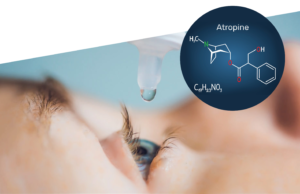March 1, 2023
By Dwight Akerman, OD, MBA, FAAO, FBCLA, FIACLE
 Low concentration (0.01% to 0.05%) atropine effectively slows myopia progression in children. However, it is unknown whether the nightly use of low-concentration atropine eye drops affects the incidence of myopia in children.
Low concentration (0.01% to 0.05%) atropine effectively slows myopia progression in children. However, it is unknown whether the nightly use of low-concentration atropine eye drops affects the incidence of myopia in children.
The Low-Concentration Atropine for Myopia Prevention (LAMP2) trial was conducted to assess the efficacy of low-concentration atropine in delaying myopia onset among children. It found that among Chinese children 4 to 9 years old without myopia, nightly use of 0.05% atropine eye drops compared with placebo resulted in a significantly lower incidence of myopia and a lower percentage of participants with fast myopic shift at two years.
This randomized, placebo-controlled, double-masked trial, conducted at the Chinese University of Hong Kong Eye Centre, enrolled 474 non-myopic children between the ages of 4 and 9 (mean age: 6.8, 50% female) with cycloplegic spherical equivalent between +1.00D to 0.00D and astigmatism less than -1.00D. They were assigned at random to the 0.05% atropine (n = 160), 0.01% atropine (n = 159), and placebo (n = 155) groups and had eye drops applied once nightly in both eyes over two years.
Of the 474 randomized patients (mean age, 6.8 years; 50% female), 353 (74.5%) completed the trial. The two-year cumulative incidence of myopia in the 0.05% atropine, 0.01% atropine, and placebo groups were 28.4% (33/116), 45.9% (56/122), and 53.0% (61/115), respectively, and the percentages of participants with fast myopic shift at two years were 25.0%, 45.1%, and 53.9%. Compared with the placebo group, the 0.05% atropine group had significantly lower two-year cumulative myopia incidence (difference, 24.6% [95% CI, 12.0%-36.4%]) and percentage of patients with fast myopic shift (difference, 28.9% [95% CI, 16.5%-40.5%]).
Compared with the 0.01% atropine group, the 0.05% atropine group had significantly lower two-year cumulative myopia incidence (difference, 17.5% [95% CI, 5.2%-29.2%]) and percentage of patients with fast myopic shift (difference, 20.1% [95% CI, 8.0%-31.6%]). The 0.01% atropine and placebo groups were not significantly different in two-year cumulative myopia incidence or percentage of patients with fast myopic shift.
The researchers concluded that although 0.05% atropine eye drops resulted in a significantly lower incidence of myopia at two years compared with placebo, further research is needed to replicate the findings and to understand whether this represents a delay or prevention of myopia.
Abstract
Effect of Low-Concentration Atropine Eyedrops vs. Placebo on Myopia Incidence in Children: The LAMP2 Randomized Clinical Trial
Jason C. Yam, Xiu Juan Zhang, Yuzhou Zhang, et al.
Importance: Early onset of myopia is associated with high myopia later in life, and myopia is irreversible once developed.
Objective: To evaluate the efficacy of low-concentration atropine eyedrops at 0.05% and 0.01% concentration for delaying the onset of myopia.
Design, Setting, and Participants: This randomized, placebo-controlled, double-masked trial conducted at the Chinese University of Hong Kong Eye Centre enrolled 474 non-myopic children aged 4 through 9 years with cycloplegic spherical equivalent between +1.00D to 0.00D and astigmatism less than -1.00D. The first recruited participant started treatment on July 11, 2017, and the last participant was enrolled on June 4, 2020; the date of the final follow-up session was June 4, 2022.
Interventions: Participants were assigned at random to the 0.05% atropine (n = 160), 0.01% atropine (n = 159), and placebo (n = 155) groups and had eye drops applied once nightly in both eyes over two years.
Main Outcomes and Measures: The primary outcomes were the two-year cumulative incidence rate of myopia (cycloplegic spherical equivalent of at least -0.50D in either eye) and the percentage of participants with fast myopic shift (spherical equivalent myopic shift of at least 1.00 D).
Results: Of the 474 randomized patients (mean age, 6.8 years; 50% female), 353 (74.5%) completed the trial. The two-year cumulative incidence of myopia in the 0.05% atropine, 0.01% atropine, and placebo groups were 28.4% (33/116), 45.9% (56/122), and 53.0% (61/115), respectively, and the percentages of participants with fast myopic shift at two years were 25.0%, 45.1%, and 53.9%. Compared with the placebo group, the 0.05% atropine group had significantly lower two-year cumulative myopia incidence (difference, 24.6% [95% CI, 12.0%-36.4%]) and percentage of patients with fast myopic shift (difference, 28.9% [95% CI, 16.5%-40.5%]). Compared with the 0.01% atropine group, the 0.05% atropine group had significantly lower two-year cumulative myopia incidence (difference, 17.5% [95% CI, 5.2%-29.2%]) and percentage of patients with fast myopic shift (difference, 20.1% [95% CI, 8.0%-31.6%]). The 0.01% atropine and placebo groups were not significantly different in two-year cumulative myopia incidence or percentage of patients with fast myopic shift. Photophobia was the most common adverse event and was reported by 12.9% of participants in the 0.05% atropine group, 18.9% in the 0.01% atropine group, and 12.2% in the placebo group in the second year.
Conclusions and Relevance: Among children aged 4 to 9 years without myopia, nightly use of 0.05% atropine eye drops compared with placebo resulted in a significantly lower incidence of myopia and a lower percentage of participants with fast myopic shift at two years. There was no significant difference between 0.01% atropine and placebo. Further research is needed to replicate the findings, to understand whether this represents a delay or prevention of myopia, and to assess longer-term safety.
Yam, J. C., Zhang, X. J., Zhang, Y., Yip, B. H., Tang, F., Wong, E. S., … & Pang, C. P. (2023). Effect of Low-Concentration Atropine Eyedrops vs. Placebo on Myopia Incidence in Children: The LAMP2 Randomized Clinical Trial. JAMA, 329(6), 472-481.













